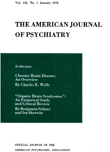CONTEMPORARY CONVERSION REACTIONS: A CLINICAL STUDY
Abstract
1. Our operational criteria for the diagnosis of conversion reactions are discussed, and an analysis of a series of 134 consecutive patients so diagnosed is presented.
2. From our contemporary point of view, 4 clinical aspects of the conversion reaction phenomenon are discussed and illustrated. These clinical aspects are : a) "classical" symptom patterns of "loss of function" and "hystero-epilepsy," b) simulation of known organic disease entities with varying degrees of expertness, c) symptom patterns in which bodily pain is a predominant feature, and d) symptom aggregates in which conversion symptoms are intermingled with those of an organic and/or psychophysiological nature.
3. In addition to patients evidencing the well-known relationship between conversion mechanisms and neurotic anxiety, in our conversion series there was a group of 40 patients with clinically evident features of depression, a group of 19 patients with clinical features of incipient schizophrenia, and a group of adolescents with characteristic ego identity problems. These subgroups were not randomly distributed within the parent group, but had significantly different parameters. We conclude that conversion reactions serve to reduce or avoid less tolerable depression, neurotic anxiety, the threat of psychotic disorganization, and the painful affects associated with adolescent ego identity problems.
4. Less than one-half of our conversion patients could be considered so call "hysterical personalities." We prefer the term "histrionic personality" to "hysterical personality," since the former calls attention to the essential characterological feature, i.e., a propensity for transparent dramatization.
5. It was found that a significantly greater proportion of our patients had occupied the position of the youngest child, or the youngest child of one sex in the family than would have been expected by chance alone. It is postulated that these and other "special person" relationships within the family group in early life may lead to difficulties in role stabilization in later life.
6. The majority of our patients regarded themselves as organically ill and a direct recommendation of psychotherapy was usually rejected. A more oblique therapeutic approach was sometimes effective. The potential therapeutic usefulness of a convalescent ward in a general hospital is suggested.
Access content
To read the fulltext, please use one of the options below to sign in or purchase access.- Personal login
- Institutional Login
- Sign in via OpenAthens
- Register for access
-
Please login/register if you wish to pair your device and check access availability.
Not a subscriber?
PsychiatryOnline subscription options offer access to the DSM-5 library, books, journals, CME, and patient resources. This all-in-one virtual library provides psychiatrists and mental health professionals with key resources for diagnosis, treatment, research, and professional development.
Need more help? PsychiatryOnline Customer Service may be reached by emailing [email protected] or by calling 800-368-5777 (in the U.S.) or 703-907-7322 (outside the U.S.).



